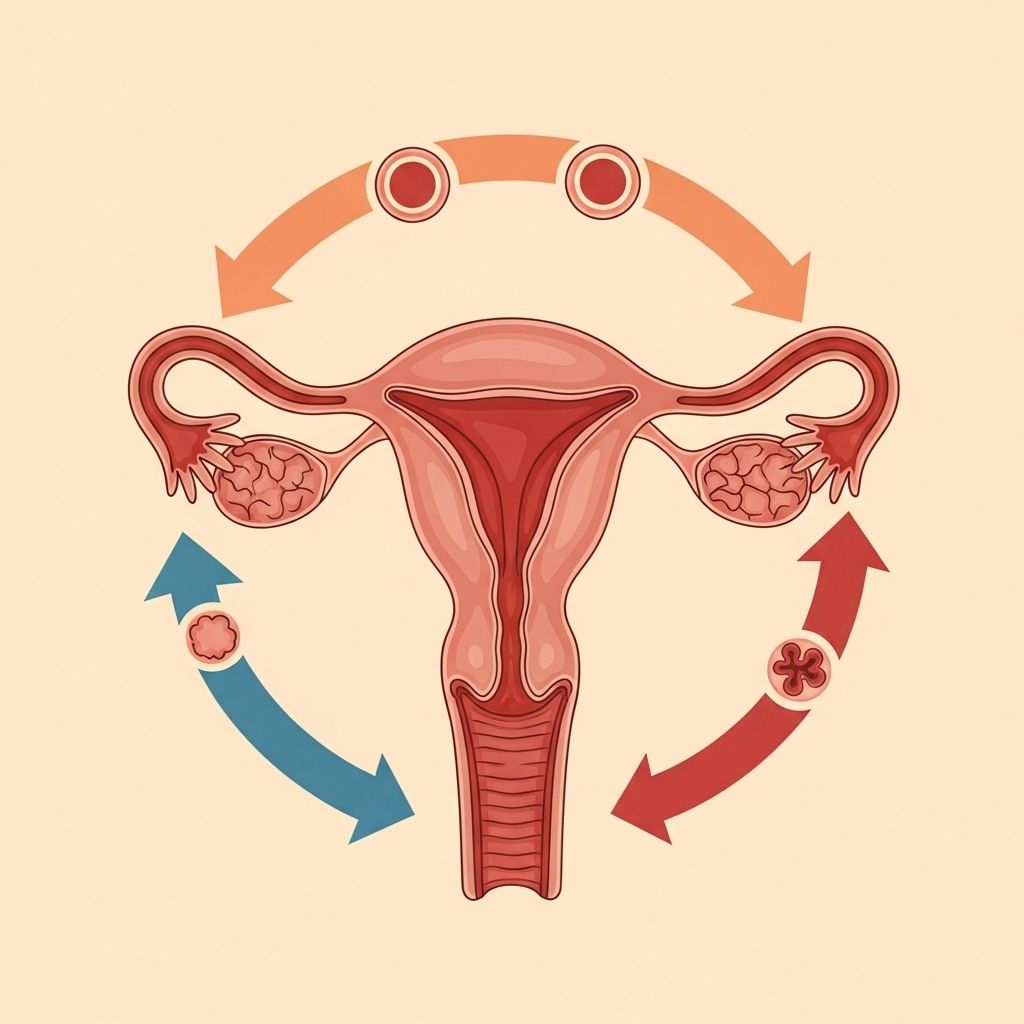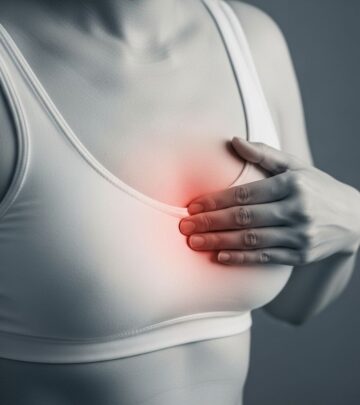Menstrual Cycle: An In-Depth Overview of Phases, Physiology, and Health
Learn all about the menstrual cycle, its phases, hormonal changes, and its impact on overall health.

The menstrual cycle is a complex, monthly process that prepares the female body for possible pregnancy. Driven by intricate hormonal signals, it enables the regular shedding and renewal of the uterine lining. Understanding the menstrual cycle’s phases and the role of its key hormones provides essential knowledge about female reproductive health and can help identify normal patterns, common symptoms, and warning signs of possible disorders.
What Is the Menstrual Cycle?
The menstrual cycle is the sequence of natural changes that occur in the female reproductive system, particularly the ovaries and uterus, to prepare the body for pregnancy. The most visible aspect is menstruation: the periodic shedding of the uterine lining, or endometrium, through vaginal bleeding. Cycles begin at puberty (menarche), with most girls starting menstruation around age 12, but variation from 8–16 years is normal. Cyclic menstruation continues until menopause, which usually occurs around age 51.
Key Facts
- Cycle Length: Typically 28 days, but anywhere from 21 to 35 days is considered normal.
- Duration of Bleeding: Menstrual periods usually last between 3–7 days.
- Hormones Involved: Estrogen, progesterone, follicle-stimulating hormone (FSH), and luteinizing hormone (LH).
- First day of period: Marked as day 1 of the menstrual cycle.
Why Do We Have Menstrual Cycles?
The cycle prepares the body for fertilization and pregnancy. Each month, hormonal signals cause the uterus to build its lining in anticipation of a fertilized egg. If fertilization does not occur, these hormones drop and the lining is shed as menstrual blood.
Phases of the Menstrual Cycle
The menstrual cycle consists of two tightly connected cycles: the ovarian cycle and the uterine cycle, each with distinct phases. Together, they orchestrate ovulation, endometrial changes, and menstruation.
| Phase | Ovarian Cycle | Uterine Cycle | Key Hormones |
|---|---|---|---|
| Days 1–14* | Follicular Phase | Proliferative Phase | FSH, Estrogen |
| Day 14 (mid-cycle) | Ovulation | Ovulation | LH surge |
| Days 15–28* | Luteal Phase | Secretory Phase | Progesterone |
*Average timing shown for a 28-day cycle; individual cycles may vary.
The Follicular and Proliferative Phases (Days 1–14)
Follicular Phase (Ovary): Begins on day 1 of menstruation. FSH stimulates growth of several ovarian follicles; typically, only one dominant follicle matures. The follicle produces increasing amounts of estrogen.
Proliferative Phase (Uterus): Rising estrogen^ prompts the endometrial lining to thicken in preparation for a possible pregnancy.
- FSH stimulates maturation of ovarian follicles.
- Dominant follicle produces high estrogen.
- Estrogen builds up the uterine lining (endometrium).
- Usually lasts about 14 days but can vary.
Ovulation (Day 14 in average cycle)
Ovulation is triggered by a surge in LH, prompted by peaked estrogen levels. The mature follicle ruptures, releasing an egg into the fallopian tube.
- LH surge (initiated by rising estrogen) triggers ovulation ~36–44 hours later.
- Cervical mucus becomes thinner and stretchier to help sperm reach the egg.
- Basal body temperature (resting temperature) may rise slightly.
The Luteal and Secretory Phases (Days 15–28)
Luteal Phase (Ovary): After releasing the egg, the ruptured follicle forms the corpus luteum, which secretes progesterone. This hormone is vital for maintaining the uterine lining.
Secretory Phase (Uterus): Progesterone matures the endometrium by increasing its thickness, vascularity, and secretory activity to potentially support a fertilized egg.
- Corpus luteum produces progesterone.
- Progesterone prepares the uterus for implantation.
- Uterine glands become highly active, storing nutrients.
- If pregnancy does not occur, the corpus luteum degenerates and hormone levels drop.
- Typical duration of luteal phase is 14 days, leading up to menstruation.
Menstruation (Start of New Cycle)
If fertilization and implantation do not occur, estrogen and progesterone levels fall, causing the uterine lining to shed. This marks the start of a new period.
- Blood, mucus, and endometrial tissue exit the body through the vagina.
- Menstrual flow typically lasts 3–7 days.
Key Hormonal Changes During the Cycle
The menstrual cycle is regulated by a feedback loop involving the brain (hypothalamus and pituitary gland) and the ovaries:
- FSH: Stimulates follicle growth during follicular phase.
- LH: LH surge triggers ovulation.
- Estrogen: Produced by developing follicle; prepares the endometrium.
- Progesterone: Produced by the corpus luteum; maintains uterine lining post-ovulation.
Normal vs. Irregular Menstrual Cycles
Although a normal menstrual cycle is commonly stated as 28 days, cycles ranging between 21–35 days are considered within the normal range for adults.
| Characteristic | Normal | Abnormal |
|---|---|---|
| Cycle Length | 21–35 days | <21 or>38 days |
| Menstrual Bleeding Duration | 3–7 days | >8 days or <2 days |
| Flow | Light to moderate | Heavy bleeding, spotting, or lack of bleeding |
Common Menstrual Symptoms
- Cramping (due to uterine contractions)
- Bloating
- Mood changes such as irritability or sadness
- Breast tenderness
- Headaches
- Fatigue
- Digestive changes (constipation, diarrhea)
These symptoms largely result from shifting hormone levels. They typically resolve after the period ends.
Menstrual Cycle Disorders and When to Seek Help
- Amenorrhea: Complete absence of menstruation for at least three consecutive cycles.
- Dysmenorrhea: Painful menstruation.
- Oligomenorrhea: Infrequent menstruation, cycles longer than 38 days.
- Polymenorrhea: Frequent periods, cycles shorter than 24 days.
- Menorrhagia: Excessive bleeding or periods lasting longer than 8 days.
Irregular cycles, severe pain, very heavy bleeding, periods missed for months, or menstrual bleeding before puberty or after menopause warrant medical attention.
Menstrual Health Tips
- Track your cycle: Note the start and end dates, duration, flow, and symptoms using a calendar or mobile app.
- Nutrition and hydration: Eat a balanced diet and drink enough water.
- Exercise regularly: Physical activity may help reduce cramps and elevate mood.
- Manage stress: Practice relaxation techniques to reduce the impact of stress on your cycle.
- Consult professionals: Discuss concerns or symptoms with a healthcare provider.
Frequently Asked Questions (FAQs)
Q: When does menstruation typically begin?
A: The average age is 12, but normal onset ranges from 8 to 16 years.
Q: How long does a normal period last?
A: Most periods last between 3 and 7 days.
Q: What can cause irregular menstruation?
A: Factors include stress, hormonal imbalances, certain medications, rapid weight changes, health conditions like polycystic ovary syndrome, thyroid problems, or approaching menopause.
Q: Is it normal to experience cramping during menstruation?
A: Yes, mild to moderate cramps are common but severe pain may signal a medical condition.
Q: What can I do if my periods are very heavy or very painful?
A: Discuss symptoms with a healthcare provider to rule out underlying conditions and explore treatment options.
Q: Can menstrual cycles affect other aspects of health, such as blood sugar?
A: Yes, hormone fluctuations may affect metabolism, blood sugar, and energy.
Conclusion
The menstrual cycle is crucial for reproductive health, reflecting complex hormonal interactions and physiological changes. Recognizing normal patterns, understanding symptoms, and knowing when to seek help are vital for maintaining overall well-being. If you experience abnormal symptoms or patterns, consult a healthcare professional for personalized advice and support.
References
- https://www.ncbi.nlm.nih.gov/books/NBK500020/
- https://my.clevelandclinic.org/health/articles/10132-menstrual-cycle
- https://www.hopkinsguides.com/hopkins/view/Johns_Hopkins_Diabetes_Guide/547090/all/Menstrual_Cycle_and_Glycemia_in_Premenopausal_Women
- https://pure.johnshopkins.edu/en/publications/menstrual-disorders-and-their-management-4
- https://www.youtube.com/watch?v=3Lt9I5LrWZw
- https://www.mayoclinic.org/healthy-lifestyle/womens-health/in-depth/menstrual-cycle/art-20047186
Read full bio of medha deb












